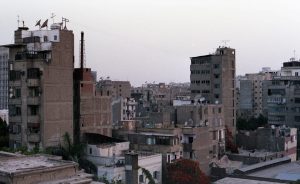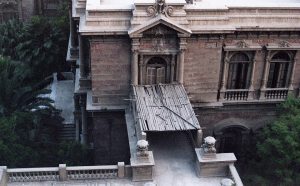كيف نوصل إلى المدينة الفاضلة؟ “يوتوبيا ” لأحمد خالد توفيق

View over Cairo’s rooftops. As there isn’t much social housing available, lots of the taller towers are built by citizens’ cooperatives.


“.أريدُ الكتابة عن كاتب مصري مشهور يدعى أحمد خالد توفيق، الذي توفي العام الماضي ألفان وثماني عشر، ومن أشهر كتبه “يوتوبيا.
تبدأ الرواية عندما يصف الراوي، أحد الشباب في مدينة “يوتوبيا”، مشهدَ رجلٍ يجثو على ركبتيّه عند أخر لحظة من حياتِه. ندرك أنّ الرجلَ شخصٌ حقيقيٌ، وأنْ راويُ القصةِ يشهدُ موتَه. في نفس الوقت يقارنُ الراويُ موتَ الرجلِ بملصقٍ شهيرٍ لفيلمِ قديمِ يحملُ صورةَ ممثلٍ تشبهُ لحظةَ الموتِ التي يشهدها الراوي. يبين توفيق، بجمله القصيرة التي يتخصص بها، أهمية العلاقة بين الفن والحياة؛ موضحًا بقوله: “عندما يصير الموت ضربًا من الجمال الفني”
جذبت انتباهي حالما وقعت عيناي على عنوان الكتاب العلاقة السابقة الذكر؛ إذ يشيرُ إلى موضوعًا أدبيًا طالما عشقتُه، ألا هو تلك العلاقة ذاتها بين الفن والحياة. يقولُ الأدِباءُ بأنْ كلمةُ “يوتوبيا” جاءت من جذرِها في اللغة اليونانية القديمة، ولها معنيان متناقضانِ. الأولُ هو “المدينة الفاضلة” والثاني هو “اللا مكان”. بدأ الأدب “اليوتوبي” في كتاب “الجمهورية” لأفلاطون، وصدرَ الكثير من الاصدارات من الأدب “اليوتوبي” على مدار القرون، وفيهم يلوّنُ لنا الكُتاب صورة للمجتمع الفاضل، و يشجعوننا على تأملِ الخلل الموجود على أرض الواقع
نستطيع، باعتقادي، تقييم رواية يوتوبيا وفقًا لمعايير الأدب اليوتوبي. فهل ندرك أكثر عن الأحوال الجارية في مصر عبر صفحات الكتاب؟
على الرغمِ من أنَّ الروايةَ تستحقُ النقدَ من عدةِ زوايا باعتقادي، إلا أنها نجحَت في أنْ تبرز لنا أخطاء حقيقية في مصر، وتسلّط الضوء على واحدة من القضايا الملحة التي تواجه الحكومة اليوم. يضع أحمد خالد توفيق الخطةَ الإنمائيةَ الحاليةَ التي تعملُ بها الحكومةُ المصريةُ تحت عدسة الميكروسكوب، ليظهرَ لجمهورِهِ النتيجةَ النهائيةَ المنتظرةَ للبلد لو ظلَ الوضع كما هو. وصفَ توفيق مصر المستقبلية عام ٢٠٢٣ ، حيث تفارقَت طبقات البلد عن بعضها، وصارَ الأثرياءُ يعيشونَ بمنطقةٍ محميةٍ مغلقة ومحاطة بسورٍ في الساحل الشمالي، بينما يُبقونَ الفقراء خارج مركز الثروة يتنافسونَ للحصول على مؤن لا تكفيهم. وقد حصل ذلك فعلا على مدار السنين الماضية، حيث صار الساحل الشمالي مقصدًا سياحيًا لإغناء البلد، وامتلأت الشواطئ بالمنشآت السكنيّة الخاصة التي تزدحمُ بالناس في الصيف ثم تخلو منهم في الشتاء تاركينَ هيكل المدينة بدون سكّان وراءَهم
تحدثُ الباحث أحمد زعزع، المتخصص في تخطيط المدن، لـ”مدى مصر” عن عدم الاستدامةِ والمصلحة العامة في بنيةِ تطويرِ المناطقَ العمرانيةِ في الساحل الشمالي الآن
يرى زعزع بأنه لو كانَ ثمةَ أيُ تخطيطٍ عمراني، فقد كانَ يقتصرُ على ضمان ألا يحصل المقاولون على أراضٍ تكون تابعة لوزارة البترول أو القوات المسلحة، وفيما عدا ذلك كان ثمة ضوء أخضر لبناء المصايف. وهو يرى أن «هذا النوع من العمران ليس مستدامًا من النواحي البيئية والاجتماعية والاقتصادية، فهو يخلو من أي نشاط اقتصادي طوال تسعة شهور من السنة، وهو يلبي احتياجات طبقة صغيرة من المجتمع فقط
و بالتالى فأن”يوتوبيا” لأحمد خالد توفيق، مع تركيزه على خلل الاقتصاد والتنمية في مصر وغيرها، ليست محاولة لتصوير مجتمع كامل، ولكنها “ديستوبيا” أو صورة المجتمع في المستقبل عندما ازدادَت الأوضاع سوءًا. بينما يطرحُ الأدب الطوباوي صورة المدينة الفاضلة، يمكنُنا القول بأنّ الأدب الديستوبيا (المدينة الفاسدة) يلفت انتباهَنا إلى أن الضغط المستمر في المجتمع سيؤدي بالنهاية إلى الانهيار. يشير توفيق إلى النزاع الذي قد يظهرُ بسبب التهميش والإقصاء من ناحية الاقتصاد والتنمية العمرانية
كما ويصف توفيق اللحظة التي التقى بها إثنان من سكّان المدنية المغلقة “يوتوبيا” وباثنان غيرهم من الفقراء الذين يعيشون خارج جدران “يوتوبيا”. لا يلقي الكاتب الضوء على الانفصال بين هؤلاء فقط، ولكنه يبيّن لنا بوضوحٍ تزايد العنف الذي يسببه هذا النوع من “التنمية” العمرانية التي تركز على فئات محددة من المجتمع. يصف الكاتب وجود المارينز المستمر بـ”يوتوبيا” لحماية الأثرياء، وتبدأ الرواية بمشهدَ الرجلٍ الفقير الذي يجثو على ركبتيّه الذي ذكرناه أعلاه بقوله: “بعد ما مزقَته رصاصاتهم”
وشاهدنا أن الوضع قد مال إلى الانفجار في مصر في المظاهرات التي حصلت في سبتمبر الماضي عندما عبرَ عدد كبير من المتظاهرين الذين تم اعتقالهم في تقرير النيابة العامة أنّ الظروف الاقتصادية الصعبة هي من دفعتهم إلى التظاهر
من جهة أخرى فأعتقد بأن توفيق لم يعرض العنف بالشكل الصحيح؛ وهذا يعود بنا إلى مسألة العلاقة بين الفن والحياة الحقيقية. تكمن قوة الأدب الطوباوي، باعتقادي، في تبيانه لحقيقة الخلل الموجود في المجتمع، وباقتراحه سياسات لمعالجة الخلل أكثر عادلًا
في الفقرات التي يصف فيها توفيق شكل شخصيات “يوتوبيا” شعرتُ بأنني كنتُ أقرأ كتابة شيخ يتذمر من سلوك وأشكال شباب أيامنا هذه، بدلًا من رسمه صورة دقيقة للعادات ومواقف الذين يسيطرون فعلًا على ثروات العالم. وكانَ يعصي عليّ أيضًا التفريق بين صوت توفيق ذاته وصوت الراوي الغني المدلل الذي يحكي القصة عندما يُظهر الفقراء بوصف يثير الاشمئزاز. وهذا الارتباك في رؤيتي نتيجة تركيزه على شكل الشخصيات في القصة، وحتى على أشكال العنف، بدلًا من على أسباب العنف وتأثيراته بشكل أعمق
كتبَ الفيلسوف السلوفيني “Zizek” أنَّ “أشكال جديدة من الفصل العنصري الاجتماعي، مثل الجدران والأحياء الفقيرة الجديدة” قد تؤدي إلى معارضة قوية وملحة وعاجلة كفاية لتؤدي إلى تغيير سياسي اليوم. يستطيع الأدب “الديستوباوي” أنْ يوضح لنا الأحوال التي قد تسبب تغييرًا سياسيًا، ويستطيع الأدب الطوباوي أن يخلق صورة لمجتمع أفضل. ولكنني اعتقد بأن توفيق حصر الرواية في وصف الشخصيات بدلًا من التركيز على العلاقة بين الطبقات بشكل أعمق وأكثر تحليلًآ، وهو ما قلل برأيّ من قيمة هذه الرواية
I want to write about a famous Egyptian author called Ahmed Khaled Tawfiq who passed away last year, and one of his most famous books, “Utopia.”
The novel begins as the narrator, one of the young people from the town of Utopia, describes a scene in which a man is kneeling on the ground during the last moments of his life. We understand that this is a real man, and that the narrator of the story is witnessing his death. Yet simultaneously the narrator describes a famous film poster he has seen, which pictures the death of an actor in a fictional moment which resembles the real-life scene he can see now. Through his short and harshly punctuated sentences, Tawfiq demonstrates to us the importance of the relationship between life and art, as the narrator reflects on “when death becomes a kind of fine art.”
ُThis relationship drew my attention as soon as I laid eyes on the book’s title, as it refers to a genre of literature I’ve been interested in for a long time, and which also deals with the relationship between literature and real life. Literary academics tell us that the word “utopia” is rooted in Ancient Greek, and has two contradictory meanings. The first meaning is “the perfect place” and the second is “nowhere.” Utopian literature began with Plato’s “Republic,” which imagined a more comprehensive and democratic politics for the Ancient Greek civilization, and continued over centuries with many different iterations of the genre. Writers would paint a picture of the perfect society for their readers, while encouraging us at the same time to contemplate the faults which surround us.
We can evaluate Tawfiq’s Utopia by these standards. Like the rest of utopian literature, does his narrative help us to understand more about what’s going on in Egypt?
Although the book can be criticized in some respects, I think it helps to draw out several ongoing problems in Egypt, and to shed light on one of the most urgent issues that the government faces today. Ahmed Khaled Tawfiq put the government’s development plans under the microscope, in order to show his audience the final result awaiting the country should things continue as they are. Tawfiq creates a picture of Egypt in 2030, in which the social classes have grown apart, and the wealthy have begun living in a separate, walled-off and closed state in the North Coast, while they keep the poor people away from the centre of wealth, where they must compete for insufficient resources. The situation he describes resembles what has happened in Egypt over the past few years, as the North Coast has become a tourist destination for the country’s wealthiest few, and the shores have become dominated by private compounds which are filled with crowds of people over summer, only for the crowds to fade away over winter and leave the skeleton of a settlement behind them.
Ahmed Zazaa, a researcher who specializes in urban planning, told Mada Masr about the lack of sustainability and public benefit in the underlying structure of the kind of urban development going on in the North Coast.
If there was any planning at all, Zazaa things it probably only stretched to ensuring that no one got hold of lands belonging to the Petroleum Ministry or the Armed Forces, and that aside from that private contractors were given the green light to build summer housing. He added that “this kind of urbanization isn’t sustainable environmentally, socially or economically, since it is completely lacking in economic activity for nine months of the year.”
Thus Tawfiq’s Utopia, with its focus on Egypt’s economic flaws, and on the trajectory of development both in and outside of Egypt, is not an attempt to depict a perfect society, but rather a dystopia, or a picture of a future state were things have got worse. While utopian writers depict things in a better condition, it could be said that dystopian writers draw our attention to underlying tensions which could lead us to breaking point. Tawfiq points to the conflict which could be incurred as a result of the progressively increasing exclusion and marginalization from both urban and economic perspectives.
As Tawfiq narrates the encounter between two inhabitants of the gated Utopia and two of those excluded from it. Not only does the novel present us with a clear picture of the separation between those two classes, but it also demonstrates the increasing violence entailed in this kind of “urban development”, which focuses only on raising the conditions for a particular part of society. Tawfiq describes to us the constant presence of the American marines in Utopia, in order to protect its inhabitants, and the novel begins with the scene I mentioned above; of a poor man who is kneeling “after their bullets ripped through him.”
Likewise, it has become apparent in today’s Egypt that the conditions are ready to tip over the edge into violence and unrest, after the peaceful protests which happened this September. After over 4,000 people were arrested, the public prosecutor’s investigation revealed that many of them complained that difficult economic conditions had pushed them to take to the streets.
Yet it is also in Tawfiq’s portrayal of violence that I think his novel is wanting, a point which returns us to the question of the relationship between life and art. Utopian literature has the power to reveal to us the true nature of the flaws in our society, by suggesting to us policies which would create a fairer world.
In the passages in which Tawfiq describes the characters living in Utopia, I often felt that I was reading the writing of an old man mumbling about the manners and looks of youth these days, rather than a clear delineation of the attitudes and habits which prevail among those who control the world’s wealth. And it was also difficult sometimes to discern whether it was Tawfiq himself, or the young spoiled narrator, who was choosing to describe poor people as a “disgusting” phenomenon. This confusion, for me, is a result of his choosing to focus on the appearances of his characters, and even on the aesthetics of violence, rather than on examining its causes and effects more comprehensively.
The Slovenian philosopher Slavoj Zizek has written about how “new forms of apartheid, such as walls and new slum neighbourhoods” could lead to the kind of opposition strong and urgent enough to result in major political change, and utopian literature can help us to envision what a better politics could look like. Yet I think Tawfiq has limited the impact of his novel by focussing on superficial character portrayals, rather than on the relationship between the classes in a more analytical sense.
